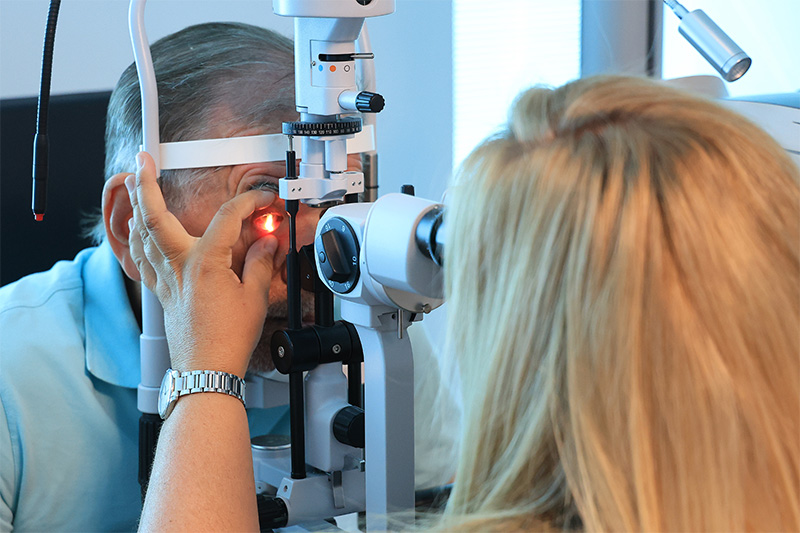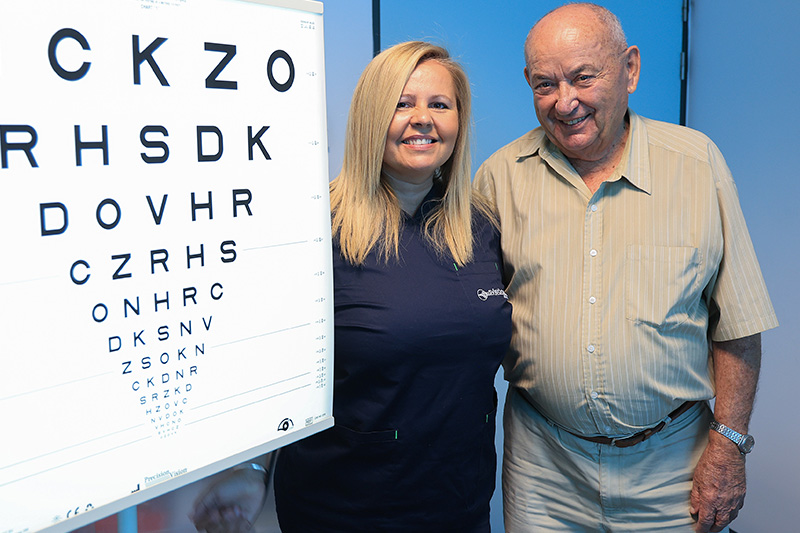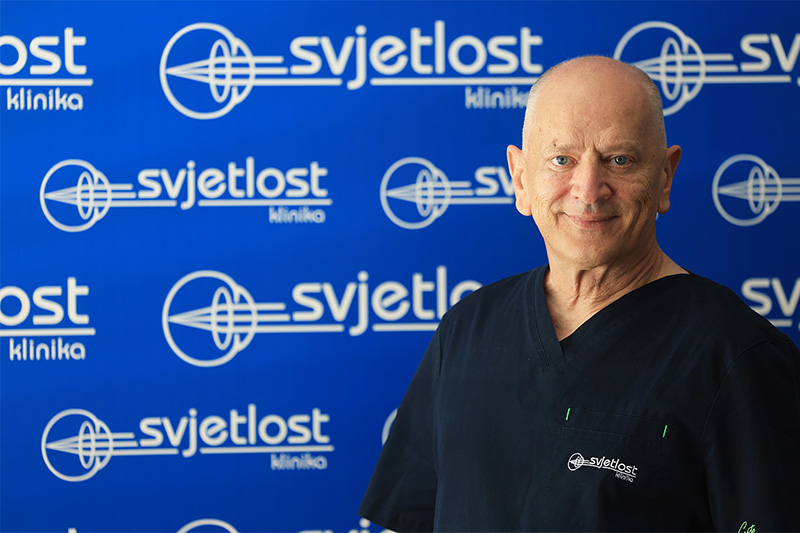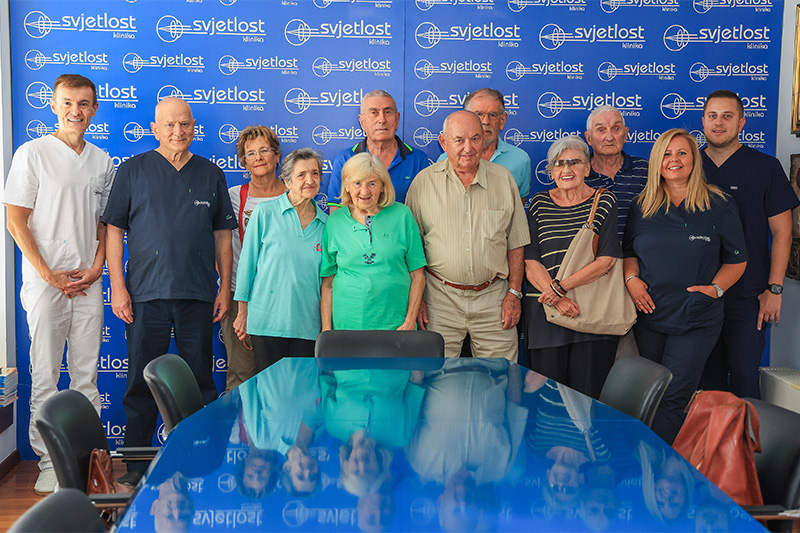For Večernji list, in the first major report after the revolutionary procedures of implanting the telescopic lens, Professor Nikica Gabrić talks about an innovation that changes lives.
The surgical procedure of implanting the SING IMT telescopic lens is intended to treat the most severe form of age-related macular degeneration (AMD).
In an interview with journalist Elvis Sprečić, Professor Gabrić reveals why the Svjetlost Clinic was among the first in Europe to start this surgery, why we strongly advocate for the lens to be available to all patients, and what life is like after regaining vision.
Below we present the story and interview in full, with details of the procedure, patient experiences, and data that confirm that this is not just medical news, but one of the greatest breakthroughs in modern ophthalmology.
Revolutionary procedure and telescopic lens could save the vision of thousands of patients
The Svjetlost Clinic is the first in Croatia and among the first in Europe to perform the surgical procedure of implanting a telescopic lens, which treats the most severe form of age-related macular degeneration (AMD).
The lens has an optical system that magnifies the image 2.7 times and projects it onto the healthy part of the retina outside the damaged center, which allows for a significant improvement in perception and visual acuity.

“I couldn't count the fingers someone would show me from a distance of more than a meter. Today I can see better with my right eye than with my left, the image in it is bigger and clearer", says the 76-year-old patient.
For fifteen years you have been fighting a battle with an enemy who is gradually taking over your territory. When it takes it completely, you will be left in the dark. In this case, the territory is your eye, or rather a small part of the retina in its center called the macula, which is responsible for the sharpest vision, recognizing details, colors, and faces. The enemy is a vicious disease called macular degeneration (or AMD), in which cells in the macula gradually deteriorate, leading to irreversible loss of central vision.
- It would be best to contact the Croatian Association of the Blind at Draškovićeva - these are the words with which, just before this summer, as a colleague to a colleague, as a doctor to a doctor, a Zagreb ophthalmologist told a Zagreb cardiologist whose long-standing battle with macular degeneration seemed to be nearing its end. Unfortunately, the winner, as is usually the case, was the disease.
- Thousands of times in my career, I have had to deliver bad news to patients or their families, to confront them with the cruel truth that we were unable to resuscitate their partner, brother, parents, children. Therefore, I was ready to hear what no one wanted to hear. That I will lose my vision - a 76-year-old cardiologist told us. He adds that, in a way, he had been mentally preparing for this since 2010, when he was diagnosed with macular degeneration in his right eye. Over the past decade and a half, his AMD has been treated in several ways, including the most well-known treatment of receiving anti-VEGF injections into the eye, and he has also undergone one surgery, but all of this, as it turned out in early June of this year, was just a postponement of the inevitable.
- When I heard those words about joining the association of the blind, no matter how much I had subconsciously prepared for it, it still hit me hard. It was the trigger that made me start thinking quickly, and so it occurred to me that in the process of treating my macular degeneration in 2014, I was briefly a patient at the Svjetlost Eye Clinic. I was treated with injections there for a while, and the doctors and staff there, I must point out, treated me in a truly noble manner. I thought about it and realized that it was there that I had the best experience among all the state and private institutions I visited, so I decided to go to Svjetlost to get another opinion - says the cardiologist.
He came for an examination at Assist. Prof. Nataša Drača, who specialized in diseases of the posterior segment of the eye, who told him, as he already knew, that his situation was extremely serious, but also gave him some good news. Very good.
Through surgery, they were able to implant a new generation of implantable telescopic lenses intended for people in the late stages of AMD, which would not only prevent vision loss but would also allow them to once again recognize faces, watch television, and even the screen of a tablet or mobile phone, or read, after a few weeks of adaptation.
It sounded almost ideal, and considering that as a society we are somehow accustomed to welcoming everything that sounds (too) good with a dose of skepticism, a logical question arose: why did no one else offer such a solution to this patient who has been suffering for so many years, but instead they wrote him off and referred him to the Croatian Association of the Blind. The answer is, in essence, very simple - because there was no such solution in our country, and more or less in all of Europe.
The Svjetlost Clinic was the first in the “Old World”, with the exception of Germany, to begin implanting this lens, which places the institution among the European pioneers of such a procedure.
So far, they have performed ten operations, eight of which were performed by the founder and owner of the clinic, Professor Nikica Gabrić, PhD, MD and two by his colleague Professor Ratimir Lazić, PhD, MD.
- This is a revolutionary procedure for people who do not see well and have certain indications, primarily macular degeneration and geographic atrophy, but also some other diseases that permanently damage the vision in the patient's eye. The devices used to date in the treatment of these diseases are not nearly as effective as the telescopic intraocular lenses that we have had the opportunity to implant thanks to Samsara, the company that designed and created this lens. They donated ten lenses to us, which is why we implanted them completely free of charge to our patients - told us Nikica Gabrić, who explains that the surgical procedure is performed under local anesthesia and, depending on the experience and ability of the person performing the surgery, lasts between 20 and 30 minutes.
- It was a virtuoso move, executed so elegantly and quickly that I didn't even have time to thank Professor Gabrić before he left. After I was anesthetized, I didn't feel anything, and it seemed to me, even though they told me it took twenty-something minutes, that everything was done in approximately ten minutes - recounts 76-year-old cardiologist.
We asked him how he sees today, about a month and a half after the surgery.
- Before the surgery, the letters I was looking at were completely distorted, they looked like a flag waving in the bora wind, and it was impossible for me to read. I couldn't count the fingers someone was showing me from a distance of more than a meter. I see your face now, and if we had spoken two months ago, it would have looked like the faces of people who censor a TV program, almost completely unrecognizable. Interestingly, today I can see better with my right eye than with my left, the image in it is bigger and clearer. We all see binocularly, with two eyes, so it can happen to me that I see two images, but that too will be corrected in the coming months through rehabilitation under the watchful eyes of Assist. Prof. Drača - he says.

Figure 1: Assist. Prof. Nataša Drača, PhD, MD, specializing in diseases of the posterior segment of the eye, with a patient who has had lenses implanted.
She describes us in detail some, so to speak, technical specifications of the implantable miniature telescopic lens itself, which is also called the SING IMT.
- This glass lens has an optical system that magnifies the image 2.7 times and projects it onto the healthy part of the retina outside the damaged center, which allows for a significant improvement in perception and visual acuity. Unlike the external telescopic glasses used so far, which have a narrowed field of view (up to 20°), SING IMT covers 54° of the central field of view, does not deform the aesthetics of the face and frees the user from the need for constant head movements when looking. At the same time, unlike standard intraocular lenses, it is the only option that restores both near and distance vision in severe forms of AMD, while competing devices offer a significantly smaller effect or are limited to only one segment of vision - explains Dr. Drača.
Although each patient has their own story describing how the lens implantation changed their quality of life, here is what, so to speak, cold, statistical data say.
Based on 10 procedures performed in Croatia so far, patients have experienced a more than twofold improvement in mean visual acuity (from 0.12 to 0.25), which corresponds to an average jump of +17 letters on the ETDRS scale.
Statistically, 85% of operated patients can read newspapers again, while 57% of them can recognize faces from two meters away. Endothelial cell loss, an indicator of the safety of the surgery, was less than 10%, confirming the safety and success of this method. In addition, there were no serious complications after the procedure, and most minor side effects were resolved without lasting consequences.
- These results confirm agreement with leading international data, where in larger European cohorts (studies from Italy and Germany) 97.1% of patients experienced improvement in central vision, while half improved by three or more lines on visual acuity tests. Reading speed and stability also more than doubled, and quality of life increased significantly after a short period of postoperative rehabilitation - summarizes Dr. Drača.
Ivica Mučnjak from Zagreb, at the age of 87, is one of the oldest patients who had a lens implanted. Since the surgery was performed last year, we asked him, as someone who has gone through all the stages of post-operative recovery and rehabilitation, how he sees today.
- The summary is that the big spot that was in the middle of my eye the whole time has completely disappeared. I was diagnosed with the disease back in 2012, in both eyes, and after just a few years, the only way to see anything at all clearly was to "target" what I wanted to see with my peripheral vision. It was tiring, after just a few hours of the day my head would start to hurt, so I would lie down, close my eyes, and have no desire to do anything. The days were slipping away. Today, at 87, I can read and watch television, although I can't drive. I had to spend several months doing certain exercises that Dr. Nataša Drača recommended, which take between 15 minutes and half an hour a day, to get rid of my double vision. That was, let's call it, a harder part of the rehabilitation, but compared to how it was before, this is literally as different as night and day - says this 87-year-old man, recounting his experience, who is now a fully functional member of society who does not need anyone's help in his daily functioning. Besides the fact that this story is, one might say, humanly beautiful or, as we often say, warm, there is also a colder, but by no means negligible, side to it.
Late AMD studies cause enormous costs to the system, and can cost the state up to 27,773 euros per patient per year due to blindness and related care costs.

Figure 2: Professor Nikica Gabrić, PhD, MD
- It is true that lens implantation is an expensive procedure that patients generally cannot afford on their own, but if they could obtain this aid with the help of the state system, it would significantly improve their quality of life, and, financially speaking, it would be cost-effective for the state after one to several years, depending on the patient. We at Svjetlost strongly advocate for SING IMT to be included on the list of aids of the Croatian Health Insurance Institute and to be available to all Croatian citizens. We have already launched an initiative with leading Croatian clinics, primarily with KBC Rebro, KBC "Sestre milosrdnice", KB Sveti Duh and KBC Split, to make this health innovation available to those who need it most. We at Svjetlost could train our colleagues in the four clinical centers I mentioned so that, if there is a desire and will at the national level, in just a few months we could have five European centers of excellence in the treatment of blindness caused by macular degeneration and open the door to hope for thousands of patients to see the world around them again - explains Professor Nikica Gabrić, noting that the Svjetlost Clinic would provide the training, which would last about three weeks, completely free of charge to all interested centers.
That this is not just a marketing ploy is also evidenced by the opinion of the profession, i.e., Croatian Ophthalmological and Optometric Society (HOOD).
"Compared to external optical aids, SING IMT offers a more natural, permanent increase in central vision without the need to wear ill-fitting glasses. Implantation is not the end, but the beginning of the process of collaboration with a therapist (doctor, nurse, etc.) in the process of overcoming monocular dominance (e.g., reading, orientation, face recognition). The subject of this report is neither the availability nor the price of SING IMT and the rehabilitation process, but only an expert assessment of the expert data published in the literature so far, and in response to the request of the members of the HOOD Board of Directors, that the Retina Division express its opinion on SING IMT based on the request of the Svjetlost Clinic to include it on the list of devices at the expense of the Croatian Health Insurance Fund. The Board of Directors of the Retina Division considers SING IMT an important professional and technological advance in the surgical approach to treating patients with dry and terminal forms of age-related macular degeneration", is stated in the conclusion signed by the Board of Directors of the Retina Division, whose members are Assist. Prof. Kajo Bućan, Assist. Prof. Damir Bosnar and Marko Lukić, PhD.
So, as can be seen from this conclusion, it is clear that the lens itself is truly revolutionary, as we have already (rightly) mentioned several times, but its implementation will not automatically solve all of the patients' problems because, above all, they must also work on themselves.
This is clearly seen from the words of another patient, a retired special education teacher, Ljerka Pompa.
- I was incredibly lucky to come to Svjetlost, and even more lucky to fall into the hands of a fantastic doctor Ivezić, who treated me with injections that I had to receive because I was a neglected case, and it was my own fault. They warned me that I had to watch out for the macula, and I ignored it for years, until at one point it became too late. At least I thought it was too late, but luckily for me, a telescopic lens arrived at the exact moment I needed it most, allowing me to continue living an almost normal life. Assist. Prof. Drača prepared me superbly for the operation, which was performed by Professor Gabrić, and then came the adjustment. At first I saw huge objects, they were oversized, but unlike before, at least I saw them. I had to learn how to create one from two images, one larger and one smaller. Assist. Prof. Drača literally taught me as if I were a first grader: look straight ahead, don't look right, don't look left, do this and that and it will get better. And indeed, every time I came back to her, it got better and better, the spot disappeared, and today, almost two years after the surgery, the images are no longer separated at all. And because of my experience, I would be very happy if as many people as possible could get this, as I call it, telescope, because after I had it implanted, I went from a depressed old woman to a spirited teenager.
Journalist: Elvis Sprečić
Photos: Marko Prpić/Pixsell



